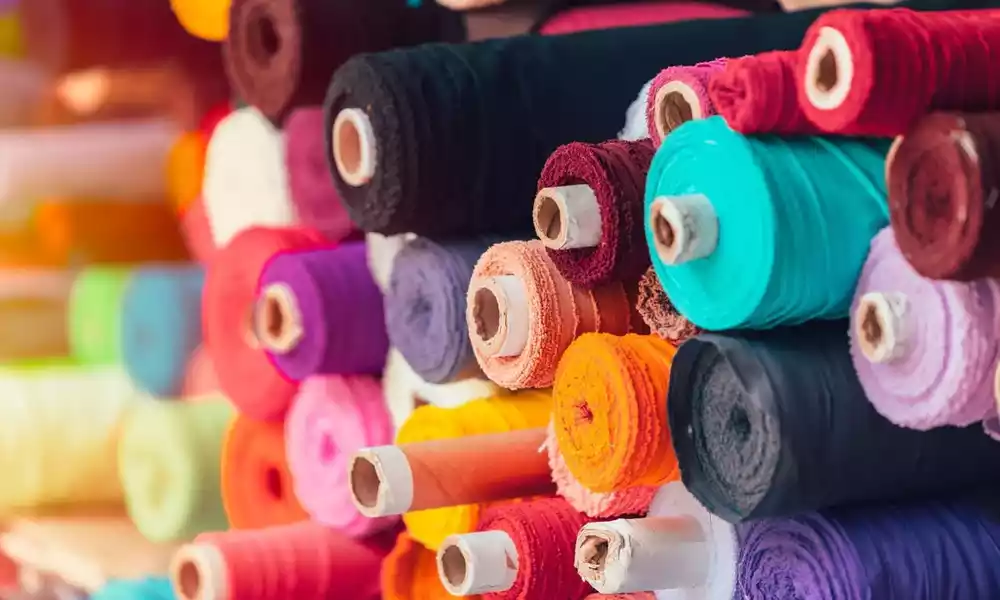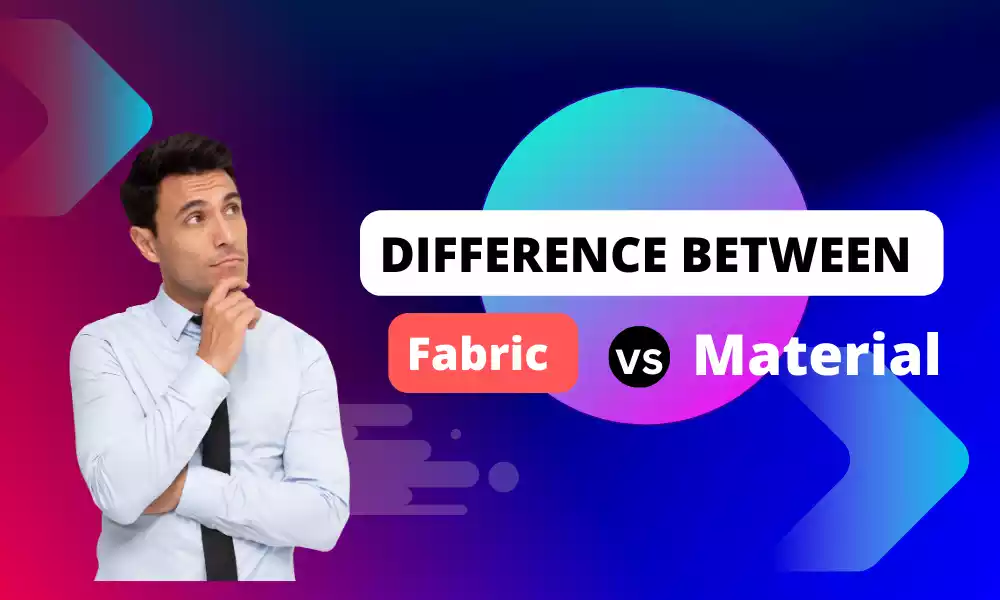An Introduction on Fabric and Material
Understanding the difference between fabric and material is integral in making informed decisions in various aspects of our lives. Although often used interchangeably, fabric and material possess distinct meanings and applications.
We will explore the definitions, characteristics, types, and uses of fabric and material, before discussing their key differences between each other. By the end, you should have an in-depth knowledge of these substances as they apply to different industries and daily life – we’ll start by outlining each definition individually.
Definition of fabric
Fabric is a flexible material produced through weaving, knitting, or felting of fibers together to form textile material that has a uniform structure. Fabric can be created from natural fibers like cotton, silk, or wool as well as synthetic ones like polyester nylon rayon.
Fibers are selected, spun into yarns then interlaced together into continuous sheets of fabric that have many applications such as clothing home textiles upholstery, etc. Fabrics also possess specific characteristics like texture strength breathability absorbency which make them suitable for various uses.

Definition of material
Material refers to any substance or matter used to fabricate something. This term encompasses natural and synthetic substances that can be altered through shaping, joining or processing to fulfill various applications and needs.
Materials can take on different physical and chemical forms. Examples include wood, stone, metal, plastic, rubber, glass and more. Material selection depends on many variables, including desired strength, flexibility, transparency, conductivity, reactivity and resistance to corrosion.
Materials are utilized across industries ranging from construction to manufacturing and packaging – creating structures, products and components essential to everyday life.

Comparison Table of Fabric and Material
Sure! Here’s a comparison table highlighting the key differences between fabric and material:
| Aspect | Fabric | Material |
|---|---|---|
| Definition | A flexible material made by weaving/knitting fibers together. | Any substance used to create or construct something. |
| Composition | Made from fibers (natural or synthetic). | Can be composed of various substances (natural or synthetic). |
| Manufacturing | Woven, knitted or felted. | Molded, cast, formed, or processed. |
| Properties | Texture, strength, absorbency, and breathability. | Physical and chemical properties vary based on the material. |
| Applications | Mainly used in textiles, clothing, and upholstery. | Used in construction, manufacturing, packaging, and more. |
| Examples | Cotton, silk, polyester, nylon. | Wood, stone, metal, plastic, glass. |
This table provides a quick overview of the main differences between fabric and material.
Fabrics are specifically created by interweaving or interlocking fibers, while materials encompass a broader range of substances used for various purposes.
Fabrics are predominantly used in textiles and clothing, while materials find applications in construction, manufacturing, and other industries.
Importance of understanding the difference
Understanding the differences between fabric and materials can be critical for several reasons:
Product Selection: An understanding of fabric properties and characteristics helps consumers make more informed choices when selecting textiles or products made from various materials, whether textiles or non-textile products. By understanding their individual features and properties, individuals can select an option best suited to their own specific needs, preferences, and intended uses.
Performance and Durability: Fabrics and materials have different levels of performance and durability, which allows users to select materials suitable for enduring their intended conditions and providing functionality – for instance when selecting activewear fabrics that ensure breathability and moisture-wicking properties for enhanced comfort during physical activities.
Care and Maintenance: Fabrics and materials require specific care and maintenance routines in order to prolong their longevity, so understanding these routines will allow individuals to clean, store, and handle textiles and materials properly. Improper care could lead to damage such as shrinkage, discoloration, or other issues which reduce the lifespan or appearance of the product.
Sustainability and Environmental Impact: Fabric and material choices have significant ramifications on sustainability and the environment, so understanding their differences helps individuals make informed decisions by considering such factors as raw material sourcing, production processes, recycling/biodegradability of product components, as well as product recyclability or biodegradability or biodegradability. With this knowledge in hand, consumers are empowered to choose eco-friendly options, thus contributing towards decreasing their environmental footprint.
Design and Creativity: For designers, artists, and craftsmen looking to express their creativity effectively through fabric or material creations, knowing its characteristics and properties is critical for effective creativity. By understanding which medium best suits their goal visually and tactilely.
Safety and Compliance: Certain industries such as automotive, aerospace, and medical require stringent safety and compliance regulations. By understanding the differences between fabrics and materials used for applications requiring fire resistance, strength, or chemical resistance properties – compliance can be ensured with industry standards and regulations by choosing an appropriate fabric or material for specific tasks.
Understanding the differences between fabric and materials enables individuals to make more informed decisions, improve product performance and durability, promote sustainability initiatives, support creative endeavors and ensure safety and compliance across various industries.
A broad term encompassing various substances
Material is an umbrella term, covering various substances used in manufacturing, construction, and other industries.
Here are some key points to keep in mind about materials:
Definition: Material refers to any substance, usually in solid form, used to construct objects. This term covers both natural and synthetic substances.
Types of Materials: There are two broad classifications of materials.
a. Natural Materials: These natural substances found within nature include wood, stone, clay minerals, and natural fibers such as cotton or wool.
b. Synthetic Materials: Man-made synthetic materials include plastics, metal alloys, composites, and synthetic fibers such as polyester and nylon.
Versatility: Materials come equipped with diverse properties and characteristics that make them suited for different uses, from metals for their strength and conductivity to plastics valued for their durability and flexibility.
Specific Applications: Materials can be found across many industries and fields, such as construction, manufacturing, automotive production, aerospace production, electronics production, and healthcare. Each industry needs materials with specific properties tailored specifically for them to meet its unique requirements.
Properties of Materials: Materials have specific characteristics that determine their behavior and performance, including strength (the ability to withstand forces or loads without deforming or failing) and density (mass per unit volume of the material).
Common properties among many materials are (A) strength: The ability to resist force without deforming or failure without breaking; and (B) density (mass per unit volume).
Conductivity refers to the capacity for heat transference or sound transmission through the material. Flexibility refers to its ability to bend, stretch or deform without breaking.
Transparency refers to how light can pass through materials.
Manufacturing and Processing: Materials undergo various processes during their creation for use, such as casting, molding, extrusion, or machining. These procedures may also modify the properties and characteristics of materials further.
Environmental Implications: Selecting materials can have serious environmental ramifications, from their availability and renewability to recycling capabilities and pollution or waste generation potential. Responsible choices should aim to minimize their environmental footprint and promote resource conservation.
Understanding the nature of materials allows professionals across industries to select materials best suited for specific uses based on properties, performance, and environmental considerations. It enables informed decisions about material selection, product design, and manufacturing processes.
Fabric: Primarily used in textile-related industries
Absolutely! Below are a few key points regarding fabric’s primary uses in textile-related industries:
Definition of Fabric: Fabric is a type of material composed primarily of fibers that are made by interlacing, knitting, or bonding them together to form cloth-like material.
Textile-Related Industries: Fabric is an integral component in industries dealing with textiles, clothing, and related products. Some prominent examples of such industries include:
Apparel and Fashion: Fabrics are used to craft clothing for everyday wear, formal attire, sportswear, as well as bags and shoes.
Home Furnishings: Fabrics can also be utilized to craft curtains, upholstery, bedding, towels, rugs, and other household textiles that serve multiple functions in the home environment.
Interior Design: Fabrics play an integral role in interior design by being used to craft furniture, wall coverings, draperies, and decorative items such as wall art.
Textile Manufacturing: Fabric is used as the main raw material by textile manufacturers who create various textile products for various uses.
Fashion Design and Textile Art: Fabric is used by fashion designers and textile artists as an artistic canvas, to craft distinctive designs, patterns, and expressions using fabric as the medium.
Fabric Varieties:Fabrics come in many forms and varieties, each one offering its own set of characteristics and uses. Common fabric varieties include:
A. Natural Fabrics (made of cotton, silk, wool, or linen).
B. Synthetic (like nylon or polyester).
C. Natural (made from natural sources like flax).
D. Synthetic/Natural Combinations.
b. Synthetic Fabrics: Synthetic fabrics such as polyester, nylon, and rayon are produced through chemical processes to produce synthetic fibers like polyester. C. Blended Fabrics: Blended fabrics contain both natural and synthetic fibers with varied properties and characteristics.
Fabric Properties: Fabrics possess unique properties that make them suitable for various uses. Common fabric characteristics include habitat
Durability: This refers to how well a fabric can withstand wear, tear, and repeated usage over time.
Breathability refers to the fabric’s ability to circulate air and transmit moisture vapor transmission, while Texture refers to its tactile feel and surface characteristics, such as smooth, coarse, or textured fabric textures.
Stretchability refers to the degree to which fabric can stretch without permanent deformation and absorbency refers to its capacity for holding moisture within itself.
Understanding the fundamental use of fabric within textile-related industries is essential for professionals in these fields, as it allows them to select suitable fabrics for specific applications and take into account factors like fabric performance, aesthetics, and comfort to meet consumer preferences in this market.
Material: Obtained or processed from various sources
Of course! Here are a few key points about materials sourced or processed from different sources:
Definition of Material: “Material” refers to any substance or matter used for creating and constructing objects. This term covers a wide variety of both synthetic and natural substances that make up objects, from fabrics to concrete blocks and more.
Sources of Materials: When purchasing materials for various applications and purposes, several sources should be taken into consideration as possible sources. Some common ones are:
a. Natural Resources: Many materials come from natural resources found in the environment, including trees for wood harvesting and quarries for metal extraction, and stone quarries for quarry stone extraction.
b. Plants and Animals: Some materials come from plant or animal sources, including natural fibers like cotton, silk, and wool that are harvested through processes like harvesting and shearing.
Minerals and Rocks: Minerals and rocks can be used as materials in construction projects, granite countertops, and ceramic production, among others. Limestone can be found used for building while clay makes great porcelains.
Chemical Synthesis: Synthetic materials are usually produced through chemical synthesis, which involves the combination of various chemical compounds or elements into new substances such as plastics, synthetic fibers, and composites.
Processing Materials: Materials frequently undergo processing or manufacturing techniques to convert them to useful forms or enhance their properties, with some common techniques including:
Extraction and Refining: Raw materials extracted from natural resources must be extracted and refined in order to remove impurities and obtain purer forms – this process is common among metal extraction processes.
Chemical Reactions: Chemical processes such as polymerization, polymer blending, or alloying can be used to produce synthetic materials with particular properties by controlling reactions between chemical compounds.
Shaping and Forming: Materials can be shaped and formed using processes such as casting, molding, forging, machining, or 3D printing to give them specific shapes and dimensions for various applications. These techniques give materials unique dimensions according to their intended uses.
d. Composite Formation: Composite materials are formed by combining different materials with their individual properties in mind, such as fiberglass, carbon fiber composites, or reinforced concrete.
Material Diversity: Due to various sources and processing methods, an array of materials exists for various applications. Different materials offer unique properties like strength, flexibility, electrical conductivity, thermal resistance, or aesthetic qualities that make them suitable choices.
Understanding that materials come from various sources is vital to understanding their variety of options, especially for professionals working in industries like manufacturing, construction, engineering, and design.
By understanding where different materials originate and process they can make informed decisions regarding material selection for performance and sustainability while taking into account availability costs, environmental impact assessments, and regulatory compliance regulations.
Recap of the differences between Fabric and Material
Absolutely! Here is a breakdown of the differences between fabric and material:
Fabric: This material is composed of fibers used primarily in textile manufacturing industries such as apparel, fashion, home furnishings, and textile manufacturing. Examples include cotton, silk, polyester, and nylon fabrics.
Properties that focus on texture, stretchability, absorbency, breathability, and durability. Produced through weaving, knitting, or bonding fibers.
Material: A broad term covering various substances used for textile production.
Construction, manufacturing, automotive, aerospace, and electronics all utilize composite materials – including wood, metal, plastic, and composites – with different uses in each industry. Their properties range from strength, density, conductivity flexibility, and transparency.
Understanding these differences is crucial as they aid in:
Selecting textiles or products made of different materials with care. Ensuring performance, durability, and maintenance of any selected fabric or material. Being aware of its sustainability and environmental impacts before supporting creative endeavors or design choices.
Safety and compliance in various industries require individuals to recognize the differences between fabric and material to make informed decisions, understand their individual properties and characteristics, and choose an option suitable to their specific needs and applications.
Final thoughts on the significance of understanding fabric and material properties
Understanding fabric and material properties holds great significance, for various reasons:
Performance and Functionality: Individuals can utilize their knowledge of fabrics and materials to select options that provide desired performance and functionality, such as selecting moisture-wicking fabric for athletic wear to provide comfort during physical activities, or durable fireproof material to enhance safety during construction projects.
Comfort and Aesthetics: Fabric and material properties play a huge role in comfort and aesthetics, from breathability, softness, and texture to hues that suit desired visual aesthetics in clothing, furnishings, or artistic creations. Understanding factors like breathability, softness, and texture can assist when selecting fabrics that offer both softness against skin contact as well as achieve visual appeal for clothing, furnishings, or artistic creations.
Durability and Longevity: Knowledge of fabric and material properties allows individuals to select options that offer both durability and longevity. By considering factors like strength, abrasion resistance, and colorfastness when choosing their materials, one can select options that can withstand wear and tear, retain their appearance over time and reduce replacement needs over time.
Maintenance and Care: Different fabrics and materials require distinct maintenance and care regimes, depending on their properties. Knowing this allows for appropriate cleaning, storage, and handling practices which ensure maximum longevity and optimal performance of fabrics or materials without damage or premature degradation.
Environmental Considerations: Fabric and material choices have environmental ramifications. Understanding properties such as sustainability, recyclability, and eco-friendliness helps individuals select items that best reflect their environmental values. By opting for materials with lower environmental impact individuals can contribute to sustainability efforts while simultaneously decreasing their carbon footprint.
Safety and Compliance: In industries governed by safety regulations, understanding fabric and material properties is crucial to complying with regulations. Certain applications require materials with certain attributes like fire resistance, electrical conductivity, or chemical resistance – understanding these properties ensures the selection of materials that meet safety standards.
Innovation and Creativity: Understanding fabric and material properties drive innovation and creativity in design and manufacturing. By being aware of their capabilities and limitations, designers and engineers can push limits, explore new avenues, and craft innovative products with distinct features and functionalities.
Understanding fabric and material properties empowers individuals to make more informed decisions, increase performance, comfort, and durability, promote sustainability efforts, ensure safety compliance, and foster innovation and creativity. Fabric and material properties knowledge is indispensable in meeting desired outcomes across diverse applications and industries.
Conclusion
Understanding the distinctions between fabric and materials as well as their properties is vital to making informed decisions and realizing desired outcomes in various industries and applications.
Fabric, commonly utilized in textile-related industries, consists of fibers that offer properties such as texture, stretchability, and absorbency. On the other hand, material refers to any substance obtained or processed from various sources, with properties including strength, density, and conductivity.
Recognizing these distinctions enables individuals to select the appropriate option based on performance, durability, comfort, and aesthetics. Understanding fabric and material properties helps individuals promote sustainability, ensure compliance, foster creativity and innovation, extend product lifespan, and ensure optimal maintenance costs are reduced.
Familiarity with fabric and material properties enables individuals to make more informed choices while improving both the quality and functionality of the materials they work with.







